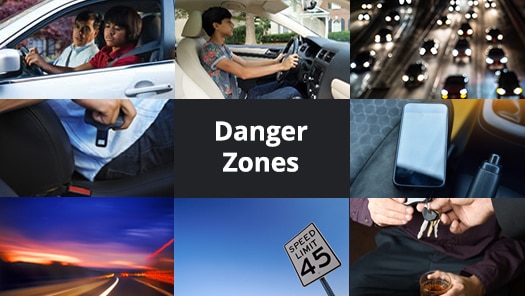Key points
Car crashes are the leading cause of death among teens ages 13–19. Yet parents, teens, and pediatricians are too often unaware of the driving conditions that are most risky for teens.
Key steps for pediatricians
Pediatricians can be valuable partners in helping families address this important health topic. Here are some key steps you can take:
Educate to reduce risk
Educate parents and teens about the dangers of teen driving and steps they can take to reduce the risks. Parents and teens should discuss their family's rules of the road and set consequences for breaking them.
Encourage use of a Parent-Teen Driving Agreement
Encourage parents to reinforce these talks by working with their teen to complete a Parent-Teen Driving Agreement. Download free copies here that you can hand out or make available.
Remind parents to lead by example
Remind parents that they need to lead by example. They can't wait until their teen is old enough to drive to start modeling good driving behaviors. Teens are more likely to engage in risky behaviors like talking on the phone while driving, texting while driving, speeding, driving while impaired, or not consistently wearing a seat belt if they see their parents engaging in these behaviors.
Spread the word
Spread the word about safe teen driving by distributing free Parents Are the Key materials in waiting and examination rooms.
Include information about safe teen driving on your clinic's website.
Educate about vehicle selection
Teens are more likely to drive older cars than adults, especially when they own their own vehicle. Older cars often lack critical safety features that could help prevent a crash or keep teens safe if a crash occurs. Parents should consider a car's safety features first and foremost when choosing a first car for a teen driver. The Insurance Institute for Highway Safety (IIHS) publishes a list of affordable vehicles that meet important safety criteria for teens. IIHS also recently released a research paper explaining the benefits of newer vehicle technologies such as crash avoidance features and teen driver-specific technologies, as well as how these technologies have the potential to dramatically reduce teen crashes and associated injuries and deaths.
Reduce the risks

As a pediatrician, you talk to your patients and their parents about important milestones and their health implications. Learning how to drive and getting a driver’s license is a milestone that comes with great responsibility and risk. Discuss the following key areas with your teen patients and their parents:
Driver inexperience
Crash risk is highest in the first year a teen has their license. Crash risk is particularly high during the first several months of having a license. Encourage parents to provide as many hours of supervised driving practice as possible over at least six months. They should practice on a variety of roads, at different times of day, and in varied weather and traffic conditions.
Teen or young adult passengers
Crash risk goes up when teens drive with other teens or young adults in the car. The best practice is for parents to instruct their teen to have no teen or young adult passengers for at least the first six months after getting their license. If that's not possible, parents can limit their teen to just one teen or young adult passenger. Parents can learn about passenger restrictions and other important provisions of their state's Graduated Driver Licensing system on the Insurance Institute for Highway Safety's graduated licensing laws by state webpage.
Nighttime driving
For all ages, fatal crashes are more likely to occur at night, but the risk is higher for teens. Parents should make sure their teen is off the road by 9 or 10 pm for at least the first six months of licensed driving.
Not using seat belts
The simplest way to prevent car crash deaths and injuries is to buckle up. Parents should require their teen to wear a seat belt on every trip—regardless of whether they're the driver, the front seat passenger, or a back seat passenger. This simple step can reduce their teen's risk of dying or being seriously injured in a crash by about half. Additionally, encourage parents to set a good example by always buckling up when in the car.
Distracted Driving
Distractions increase a teen’s risk of being in a crash. Encourage parents to ban cell phone use, texting, eating, playing with the radio, and other distracting behaviors while their teen is driving. Remind parents to set a good example by following these same rules when they are driving.
Drowsy driving
Young drivers are at high risk for drowsy driving. Parents should ensure their teen is well rested before they get behind the wheel. Teens are typically most tired and at risk when driving in the early morning or late at night, so it is best to avoid driving at those times.
Reckless driving
Research demonstrates that teens lack the experience, judgment, and maturity to assess risky situations. Parents should stress the importance of avoiding unsafe behaviors, such as speeding or driving too close to the vehicle ahead.
Impaired driving
Even small amounts of alcohol will impair a teen's driving ability and increase crash risk. Many other types of drugs/substances also have the potential to impair a teen's ability to drive safely. This could include marijuana, other illicit drugs, prescription medications, and/or over-the-counter medications. Talk to teens about the risks of driving after drinking alcohol and/or using other drugs.
Also, remind parents to be good role models. They should never drive while impaired by alcohol and/or other substances.
